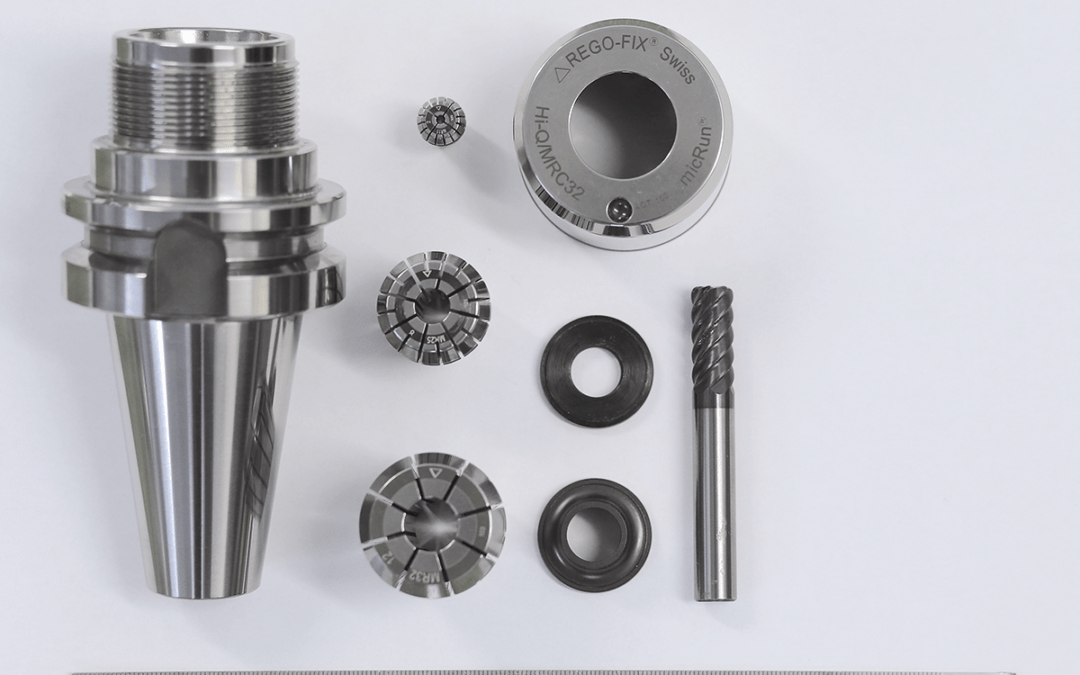Smaller components and tighter tolerances drive today’s need for speed and precision, as tools get smaller, machines get faster and high-performance cutting is now the norm. Instead of making slow, deep passes across a part, today’s machines use light cuts and fast feed rates, and blaze across the material. To maximize accuracy, that type of machining process calls for smaller tools (generally 1/2″-diameter and smaller) that exhibit minimal eccentricity or TIR (Total Indicator Runout).
TIR ranges vary for different parts of the tooling system. A standard precision ER collet typically measures 0.0004″ (10 µm) TIR and an ultra-precision collet 0.0002″ (5 µm) TIR. A high-quality toolholder typically has 0.0001″ (3.0 µm) TIR, whereas TIR for most cutting tools is about 0.0002″ (5 µm).
Part making for medical devices, electronic components and other tight-tolerance applications generally requires use of smaller, more-accurate tools to maximize accuracy and productivity. In approaching these applications, it is critical to consider both the TIR of the individual toolholding components and their performance as a system.
The combined TIR of the collet, holder and tool make up the overall TIR of the system. That can range from a few ten-thousandths of an inch for a well-matched system of precision components, up to a total TIR of 0.0005″ (13 µm) or more, exceeding many definitions of high precision. Many shops don’t fully realize that – in a worst-case scenario – this tolerance stacking can add up to a significant amount, even if all the individual components meet manufacturers’ specifications.
Minimizing TIR makes tools last longer and produce better surface finishes. When shops find tools that produce higher tool life and good finish, they often will sacrifice some tool life to increase machining parameters. Pushing the tool harder can produce more parts in the same amount of time. In internal testing, REGO-FIX has determined that TIR exceeding 0.0004″ (10 µm) negatively affects tool life.
When many shops choose tools, they may not need the high rigidity and vibration damping provided by complex systems such as powRgrip tooling, but an ordinary collet system may not provide enough accuracy. The REGO-FIX micRun® toolholding system represents a way to minimize TIR stacking and provide greater accuracy than a regular ER system, without stepping all the way up to a high-performance system. The reduced, consistent TIR of micRun tooling provides increased tool life and a chance to boost productivity.
To minimize tolerance stacking, REGO-FIX designed micRun as a complete system. Through tightly-controlled manufacturing methods, the micRun collet by itself measures less than 0.000078″ (less than 2.0 µm) TIR. A proprietary grinding process gives the micRun toolholder less than 0.000039″ (1 µm) TIR from taper to cavity, measured from the steep taper at the back of the holder to the pocket in the front. As a result, the assembled system of collet and holder consistently provides TIR of less than or equal to 0.00011″ (3 µm), measured at three times tool diameter from the face of the collet.
The application approach for a tooling system often depends on what the manufacturer produces. For example, a shop may tool up a new machine and use standard ER chucks for all regular drilling and profiling, and then apply micRun tooling for high-precision finishing of that product.
The micRun toolholder offers the advantages of a unique design. We engineered its cavity so the collet sits deeper into the pocket. A grooveless clamping nut provides low vibration and quiet operation, with proprietary threads that position the nut in the correct plane and guide it straight down as it tightens. The holder employs REGO-FIX’s hardened lubricity Hi-Q process for high clamping force in both the clamping nut and the inside of the micRun holder.
Some toolholding manufacturers claim similar performance for their systems, but they use components with different engineering, manufacturing and quality control standards, so their systems may not provide consistent results. REGO-FIX designs, measures, and manufactures all the parts for the micRun system under one roof, with system tolerances engineered to stack together consistently. Want to learn more? Contact a member of our Tech Team to discuss your specific requirements and how the micRun system might work for you.

